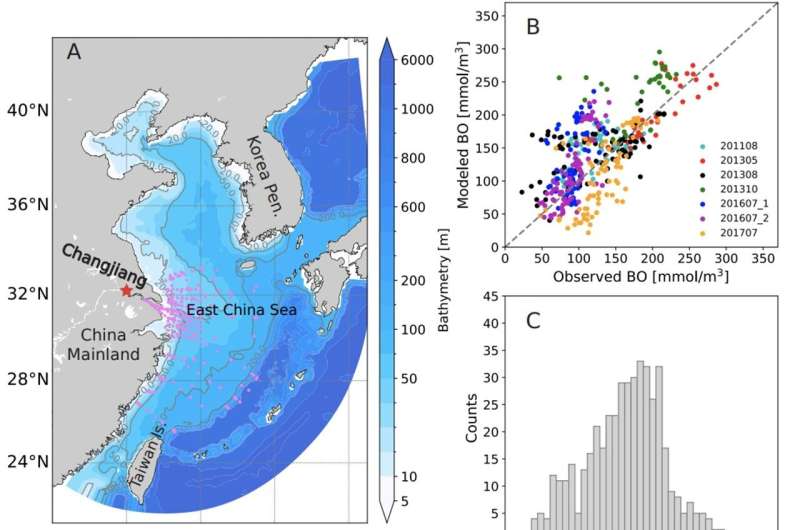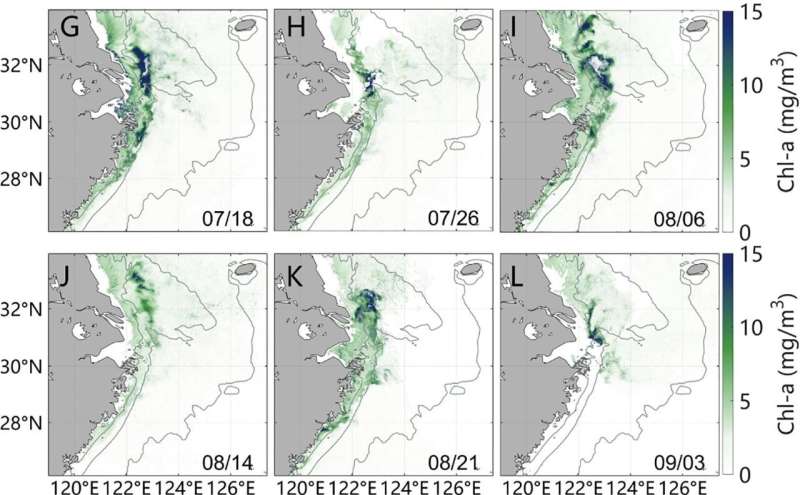April 1, 2024 feature
This article has been reviewed according to Science X's editorial process and policies. Editors have highlighted the following attributes while ensuring the content's credibility:
fact-checked
peer-reviewed publication
trusted source
proofread
Tropical cyclones may be an unlikely ally in the battle against ocean hypoxia

Tropical cyclones, also known as hurricanes and typhoons, are meteorological phenomena that occur over tropical and subtropical oceans experiencing low atmospheric pressure, where water vapor from the warm oceans condenses to produce spiraling cloud formations hundreds of meters wide. The resulting heavy rain and wind speeds exceeding 74 miles per hour can bring devastation to communities in their path when these tropical storms make landfall.
However, tropical cyclones also have distinct impacts on the marine realm. New research, published in Frontiers in Marine Science, has investigated the link between these events and primary productivity in our oceans.
Wen Yang, of East China Normal University, and colleagues focused specifically on the East China Sea, Pacific Ocean, to determine how the cycling of oxygen and nutrients is affected when a tropical storm passes through the region. Approximately 46% of tropical cyclones in the East China Sea make landfall along the country's east coastline.
This study relies upon the principle of ocean disturbance encouraging the vertical and lateral mixing of ocean waters, meaning deeper layers become better oxygenated and nutrients are supplied to a broader surface area for primary producers to thrive.
While the former scenario helps to alleviate oxygen depletion and anoxia with depth, the latter means more oxygen is consumed in metabolic processes for survival and reproduction. Therefore, the research team aimed to identify whether tropical cyclones have a net positive or negative impact on ocean oxygenation.
Combining information on tropical cyclone track and speed from previous events with satellite observations of ocean water color to measure chlorophyll concentration (therefore estimating surface phytoplankton productivity) and computational simulations, the scientists identified changes in the dissolved oxygen budget.

Surface chlorophyll data revealed high concentrations post-tropical cyclone, but with distinct changes in concentration, location and depth between years. This was further explored through modeling to compensate for cloud cover during cyclones disrupting satellite imagery, with the researchers identifying two stages in chlorophyll concentration changes.
Prior to a cyclone, there was a noticeable and rapid decrease in chlorophyll, before increasing in offshore areas after the tropical storm passed through. The second stage saw the high offshore chlorophyll concentrations decline within 4–5 days after the event, but a gradual increase near the coast, especially off the Changjiang estuary. Therefore, higher chlorophyll concentrations post-tropical storm are indicative of enhanced productivity and dissolved oxygen consumption.
For the East China Sea, they found that the key factors influencing oxygenation and primary productivity were cyclone intensity (displaying a linear relationship), combined with the distance between the typhoon's trajectory and the Changjiang estuary. These resulted in positive changes in the flux of oxygen between the atmosphere and sea surface, transport of oxygen with water movement, and the rate of oxygen consumption in organic matter decomposition.
For their study period of 2011 to 2020, the model-based oxygen budget of the ocean increased following the passage of multiple tropical cyclones (generally five per year), suggesting there is ultimately a net gain in oxygen to the ocean during these events. Consequently, there is a net positive impact on marine trophic webs and ecosystem function as a whole.
This research is significant as the net positive impact of tropical cyclones on ocean oxygenation means it is an important counterbalance to issues of deoxygenation and hypoxia (oxygen concentration <2 mg/l) in the world's oceans, exacerbated by anthropogenic activities.
As climate change continues, marine heat waves are likely to trigger more of these climatological events. As such, tropical cyclones result in a paradoxical situation—while there can be devastating consequences on land, the marine realm may well thrive as a result.
More information: Wen Yang et al, Effects of typhoons on primary production and dissolved oxygen in the East China Sea, Frontiers in Marine Science (2024). DOI: 10.3389/fmars.2024.1376432
Journal information: Frontiers in Marine Science
© 2024 Science X Network



















